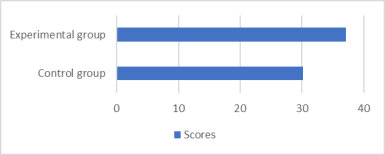At the current stage of educational development, Kazakhstan's universities of higher education must work to improve the quality of lessons, which is connected to the possibility of implementing a technological approach with the development of new state educational standards.
Science-based modern teaching methods and information technologies are beneficial to learning. This article provides an analysis of the most effective online platforms for learning English by students of the L. N. Gumilyov Eurasian National University.
The research demonstrates the effectiveness of utilizing advanced technologies in the teaching of students foreign languages by introducing training and monitoring online tools, as well as evidence of their approval in current pedagogical practice. The author gave a summary of the findings of the study and teaching experience, and used literature. The author's electronic educational resources, recommendations, and the creation of information, interaction, and material provision in other topics can all be used to teach foreign languages. The development of online platforms, multimedia, and testing programs, as well as the development of different ways to use new technologies in foreign language education, all necessitate further research.
Keywords: multimedia technologies, foreign language, university students, higher education, digital tool, online learning, apps, survey, quiz, test.
Acknowledgements . I would like to express my deepest gratitude to the department of foreign language of ENU, especially to senior lecturer Tazhitova G. Z. who was my mentor in my pedagogical practice at university. She has allowed me to conduct research and survey according to my dissertation topic. Thanks to her, I did this study and wrote the article. Moreover, I would like to thank to the Assistant Professor of the department theory and practice of foreign languages Avazbakiyeva F. R. for teaching me academic writings skills.
The variety of technologies available for use in learning and teaching languages has grown significantly in the first half of the twenty-first century, and their use in educational organizations all over the world has become part of the routine. It is reasonable to assume that digital technologies are currently receiving a large amount of attention. Some researchers refer to this time as «normalized» [1]. Many individuals throughout the world utilise digital devices in their daily lives [2], yet they are still not usually present in the educational setting. However, digital tools have long been a part of the education system, particularly in the field of language teaching. These digital tools are essential to what is a well-established field.
It should be emphasized that advanced technologies, forms, and methods of educational activities in the interactive digital world of the university include the inventive teaching methods utilized in the system of the modern education process in higher education. The main components and strategic planning of innovative educational practices in higher education should also accurately reflect the type and rate of societal change. The focus of contemporary higher education should be on the application of information technology, the expansive distribution of interactive, online learning, and the potential access to digital and technical aspects. [2]
The higher education always faces the problem of expanding and modernizing the methods of education systems. Programs in both initial and ongoing learning that address contemporary subjects like the process of learning a foreign language or the intercultural aspect are increasing. They also support the growth of academic freedom at institutions and universities that provide these courses.
According to Hall and Walsh (2002), active engagement in sociocultural activities and the environment are closely connected to the linguistic, social, and cognitive development of learners. In this way, settings apart from classrooms can have an influence on children's language development. The digital contact between students and teachers that provides social learning opportunities can be beneficial to the educational process. [3]
The purpose of this study is to experiment the effectiveness of multimedia technologies among university students.
Educational apps
Google Forms. This one is sort of a no-brainer. Google Forms, like many of the Google apps, is simple, straightforward, and efficient. It provides an easy and direct way to build surveys and quizzes, and the interface is easy to use. Results come immediately in organized reports. An essential assessment tool. And it’s 100 % free, too.
Socrative. An easy-to-use quiz app which offers a super efficient way to monitor and evaluate learning while saving time for educators. You can create multiple choice, true/false, or short answer questions, and Socrative also provides reports on results and student experience. It’s perfect for any 6–12 teacher looking to enhance their assessments.
Kahoot. Classic interactive and fun quiz-style game that students most always enjoy. You can create your own assessment, design your own questions, and receive immediate feedback using Kahoot. A teacher classic, and rightfully so. Great for in-person education and distance learning alike but it’s particularly fun in the classroom. Kahoot is a must-have for all 6–12 students.
Bamboozle . Massive databank of various online games and activities perfect for elementary and middle school students. Some of them are sillier than others, but many are educational and fun. A good resource for teachers looking to reward their students with some less strenuous but still relevant activity.
Quizlet . Classic flash-card and quiz-based website that operates as an excellent tool for individual or class-wide test reviews, informal assessments, or quick checks for understanding. Either create your own quizlet or choose one from the massive catalog of pre-existing reviews. Quizlet is perfect for 6–12 educators looking for more online resources to help students comprehend difficult concepts and develop academic vocabulary.
Visuwords is a web-based tool that helps you research the meanings of the word, the connection between those meanings and associations with other words and concepts.
Thinglink is a powerful way to use technology to make education more engaging. It does this by allowing teachers to turn any image, video, or 360-degree VR shot into a learning experience.
YouGlish is a very easy way to learn the correct pronunciation of words by hearing them spoken on YouTube videos. It is smart enough to trawl all that content to find the word or phrase you want to hear. It then offers a video with that word or phrase spoken in the language you selected. The video itself could be about anything but the important part is that the word or phrase will be spoken clearly, in many cases multiple times, so you can hear how it is correctly pronounced.
Mentimeter is an extremely powerful marketing tool that can help you build state-of-the-art presentations for your clients. Their easy-to-use online editor can help you create presentations that will keep your audience interested and engaged from the start. It allows your audience to connect to presentations where they can answer questions and give their input. This can be very helpful for teachers as you get to see their responses in real-time. It creates an interactive experience for both parties.
Experiment
The experiment involved 36 students who studied English as a foreign language at university. They were from two different groups. In each group there were 18 students. First group was chosen as an experimental group, second group was selected as a control group.
The research has lasted for 3 months. At the beginning of the semester it was taken pre-test from both groups. The placement test was consisted of 50 questions and it identified the English level of students. According to the criteria, students who got more than 30 scores were considered as intermediate students.

Fig. 1. Results of the pre-test
The pre-test results (picture 1) showed that control group showed a higher result in comparison with experimental group. The average result of experimental group was 17,59 while the students of control group got 22,57 scores. Moreover, these results demonstrated that in both groups students' level of English proficiency was under intermediate.
Students had English classes three hours per week. The control group studied the subject using only textbook and syllabus. Then, the experimental group had also textbook and syllabus. However, for the experimental group students was prepared special tasks. They took the test after each unit on online platforms such as Socrative, Google form, Quizizz, Kahoot, Wordwall. In such way, they checked their their knowledge according to the topic. Sometimes they were given project work in small groups. They also worked on searching internet resources in the classroom. In order to learn new vocabulary, students played quiz.
Result of the test
After three months, it was taken test from the students of both groups. The test consisted of 50 questions.

Fig. 2. Results of the post-test
As a result of post-test (picture 2), the experimental group had a higher result compared to the control group. The experimental group students doubled their average scores of group by 37,1 out of 50, while the result of the control group reached up by 40 %. Both groups have made a progress during the semester. However, it was seen that the special multimedia assignments for experimental group gave its effect on expanding their knowledge.
Questionnaires results
The data from questionnaires in the current study is to examine to respond to the research questions. According to Cheung [4], the questionnaire is a document consisting of a set of generic questions with a specified scheme thatdefines the precise wording and order of the questions to collect information from the respondents. Moreover, an effective questionnaire should have a clear purpose, and questions should be answered in a reasonable way, questions that are easy to understand, and responses to achieve a correct and good result. In this study, the researcher is using an open-ended questionnaire. So, the participants can answer the queries with ease, and the researcher can also easily collect the result.
Table 1
The results of the survey
|
Answers |
Number |
Percentage |
|
|
Do you study English as a foreign language? |
yes no |
16 0 |
100 % |
|
Have you ever used multimedia technologies in class? |
yes no |
15 1 |
93,8 % 6,2 % |
|
Do you enjoy completing assignments on educational platforms? |
yes no |
16 0 |
100 % |
According to table all partcipants of the survey study EFL. 93,9 % of those students have used online eduactional apps, only one students hasn’t used yet. In addition, the table demonstrated that almost all students enjoyed using online platforms.(table 1)

Fig. 3. The results of the survey
Furthermore, it was conducted survey among the experimental group students (picture 3). 16 students took part in this research. The result showed that the most preferable educational app for students was Kahoot. Moreoever, 25 % of learners have chosen Quizizz, meanwhile few percent of students considered Google Form to be the best.
Conclusion
In this article, the author presents a study based on the academic achievement of Eurasian National University students in Astana, within the context of the student’s learning. By accomplishing this, they were implementing both the requirement and the role of using technology software. The results are pleasing to have. ENU students use technology tools mainly for learning goals in the contemporary technological era, and they adapt the trend of learning English. As a result, the students expressed a willingness to use the software mentioned above in conjunction with Eurasian National University's syllabus in order to improve their language proficiency. The study illustrated the effectiveness of those apps when information is used. With various advantages and features, these applications.
References:
- Zhorabekova, A. N., Toibekova, B. A., & Torybaeva, Z. Z. (2013). Application of innovative technologies forming the foreign language future teacher’s professional competences.World Applied Sciences Journal,22(6), 779–782.
- Warschauer, M. (2013). Demystifying the digital divide.Scientific American,289(2), 42–47.
- Hall, J. K., & Walsh, M. (2012). 10. Teacher-student interaction and language learning.Annual review of applied linguistics,22, 186
- Cheung, A. K. (n.d.). Structured Questionnaires // Encyclopedia of Quality of Life and Well-Being Research, p 6399–6402







